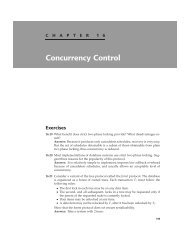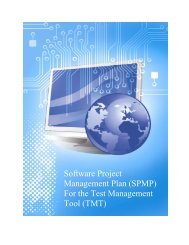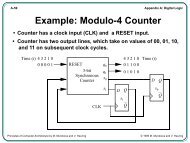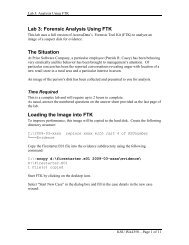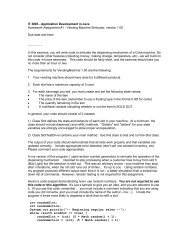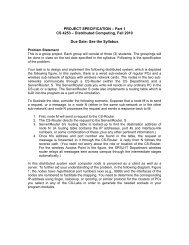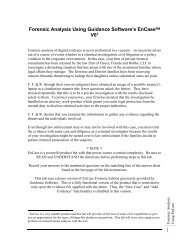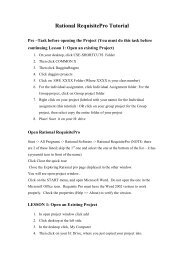You also want an ePaper? Increase the reach of your titles
YUMPU automatically turns print PDFs into web optimized ePapers that Google loves.
DRAFT, February 18, 2003, Page 97<br />
structure, even if it is on a single line. Activating a fold command with the cursor on the text of such a line<br />
will not fold the enclosing structure.<br />
Fold operations are a part of the stream of edits, and can be undone using Ctrl-Z or the "Undo" item of the<br />
"Edit" menu. "Unfold All" however, can not be undone.<br />
The fold operations are:<br />
Fold (Shift-F3) - If multiple lines of text are selected, the first to last lines of the selection become<br />
a single fold. Otherwise, the CSD structure containing the cursor is folded. If the cursor is at the<br />
top line of a multi-part structure, such as a switch statement or if-else statement, each part of that<br />
statement is folded.<br />
Fold Recursive (F3) - If multiple lines of text are selected, any CSD structures within the selection<br />
are folded recursively. If there are no CSD structures in the selection, nothing is folded.<br />
Structures partially within the selection are partially folded. If no text or part of one line of text is<br />
selected, the CSD structure containing the cursor is folded recursively. If the cursor is at the top<br />
of a multi-part structure, such as a switch statement or if-else statement, each part of that<br />
statement is folded recursively.<br />
Fold All Recursive (Ctrl-F3) - Does the same thing as selecting all text then folding recursively.<br />
Unfold (F4) - unfolds the next fold following the cursor position. For a mouse click, the click must<br />
be on the folded line.<br />
Unfold Recursive (Shift F4) - unfolds the next fold following the cursor position, and any folds<br />
within that fold.<br />
Unfold All (Ctrl-F4) - removes all folds.<br />
18.12 Marks<br />
The CSD window supports a multiple highlights called marks. Marks are separate from the selected text.<br />
They are used only for display, not for cut and copy. These highlights are transitory: they will not survive<br />
CSD generation or be saved when a file is closed.<br />
A menu is provided on the CSD window "View" menu that allows the current selection to be marked, all<br />
marks to be removed, and the text to be searched for the next or previous mark. The find dialog also has<br />
a "find all" function that uses marks.<br />
18.13 Bookmarks<br />
The CSD window provides line-oriented bookmarks. These are displayed to the left of the text, as green<br />
trapezoids. They are persistent, and will be saved and restored when a file is closed and reopened.<br />
A menu is provided on the CSD window "View" menu that allows the bookmark on the line containing the<br />
cursor to be toggled on or off, all bookmarks to be removed, and the text to be searched for the next or<br />
previous bookmark.<br />
18.14 Breakpoints<br />
Breakpoints are used in the integrated Java debugger. These are displayed to the left of the text, as red<br />
octagons. They are persistent, and will be saved and restored when a file is closed and reopened. If you<br />
are not using the integrated Java debugger, you can use breakpoints as additional bookmarks.<br />
A menu is provided on the CSD window "View" menu that allows the breakpoint on the line containing the<br />
cursor to be toggled on or off, all breakpoints to be removed, and the text to be searched for the next or<br />
previous breakpoint.



